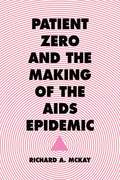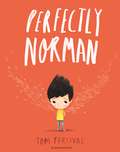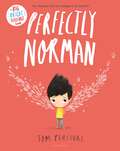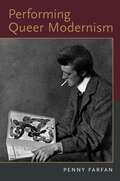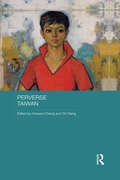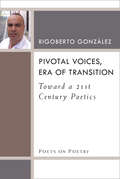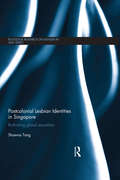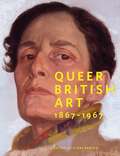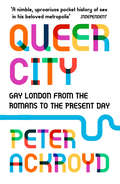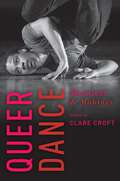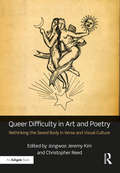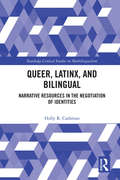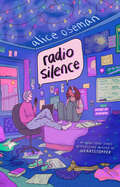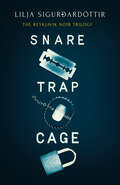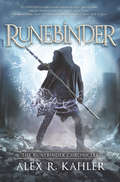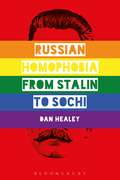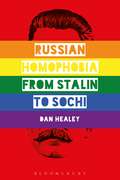- Table View
- List View
Patient Zero and the Making of the AIDS Epidemic
by Richard A. McKayNow an award-winning documentary feature film The search for a “patient zero”—popularly understood to be the first person infected in an epidemic—has been key to media coverage of major infectious disease outbreaks for more than three decades. Yet the term itself did not exist before the emergence of the HIV/AIDS epidemic in the 1980s. How did this idea so swiftly come to exert such a strong grip on the scientific, media, and popular consciousness? In Patient Zero, Richard A. McKay interprets a wealth of archival sources and interviews to demonstrate how this seemingly new concept drew upon centuries-old ideas—and fears—about contagion and social disorder. McKay presents a carefully documented and sensitively written account of the life of Gaétan Dugas, a gay man whose skin cancer diagnosis in 1980 took on very different meanings as the HIV/AIDS epidemic developed—and who received widespread posthumous infamy when he was incorrectly identified as patient zero of the North American outbreak. McKay shows how investigators from the US Centers for Disease Control inadvertently created the term amid their early research into the emerging health crisis; how an ambitious journalist dramatically amplified the idea in his determination to reframe national debates about AIDS; and how many individuals grappled with the notion of patient zero—adopting, challenging and redirecting its powerful meanings—as they tried to make sense of and respond to the first fifteen years of an unfolding epidemic. With important insights for our interconnected age, Patient Zero untangles the complex process by which individuals and groups create meaning and allocate blame when faced with new disease threats. What McKay gives us here is myth-smashing revisionist history at its best.
Patient Zero and the Making of the AIDS Epidemic
by Richard A. McKayNow an award-winning documentary feature film The search for a “patient zero”—popularly understood to be the first person infected in an epidemic—has been key to media coverage of major infectious disease outbreaks for more than three decades. Yet the term itself did not exist before the emergence of the HIV/AIDS epidemic in the 1980s. How did this idea so swiftly come to exert such a strong grip on the scientific, media, and popular consciousness? In Patient Zero, Richard A. McKay interprets a wealth of archival sources and interviews to demonstrate how this seemingly new concept drew upon centuries-old ideas—and fears—about contagion and social disorder. McKay presents a carefully documented and sensitively written account of the life of Gaétan Dugas, a gay man whose skin cancer diagnosis in 1980 took on very different meanings as the HIV/AIDS epidemic developed—and who received widespread posthumous infamy when he was incorrectly identified as patient zero of the North American outbreak. McKay shows how investigators from the US Centers for Disease Control inadvertently created the term amid their early research into the emerging health crisis; how an ambitious journalist dramatically amplified the idea in his determination to reframe national debates about AIDS; and how many individuals grappled with the notion of patient zero—adopting, challenging and redirecting its powerful meanings—as they tried to make sense of and respond to the first fifteen years of an unfolding epidemic. With important insights for our interconnected age, Patient Zero untangles the complex process by which individuals and groups create meaning and allocate blame when faced with new disease threats. What McKay gives us here is myth-smashing revisionist history at its best.
Patient Zero and the Making of the AIDS Epidemic
by Richard A. McKayNow an award-winning documentary feature film The search for a “patient zero”—popularly understood to be the first person infected in an epidemic—has been key to media coverage of major infectious disease outbreaks for more than three decades. Yet the term itself did not exist before the emergence of the HIV/AIDS epidemic in the 1980s. How did this idea so swiftly come to exert such a strong grip on the scientific, media, and popular consciousness? In Patient Zero, Richard A. McKay interprets a wealth of archival sources and interviews to demonstrate how this seemingly new concept drew upon centuries-old ideas—and fears—about contagion and social disorder. McKay presents a carefully documented and sensitively written account of the life of Gaétan Dugas, a gay man whose skin cancer diagnosis in 1980 took on very different meanings as the HIV/AIDS epidemic developed—and who received widespread posthumous infamy when he was incorrectly identified as patient zero of the North American outbreak. McKay shows how investigators from the US Centers for Disease Control inadvertently created the term amid their early research into the emerging health crisis; how an ambitious journalist dramatically amplified the idea in his determination to reframe national debates about AIDS; and how many individuals grappled with the notion of patient zero—adopting, challenging and redirecting its powerful meanings—as they tried to make sense of and respond to the first fifteen years of an unfolding epidemic. With important insights for our interconnected age, Patient Zero untangles the complex process by which individuals and groups create meaning and allocate blame when faced with new disease threats. What McKay gives us here is myth-smashing revisionist history at its best.
Patient Zero and the Making of the AIDS Epidemic
by Richard A. McKayNow an award-winning documentary feature film The search for a “patient zero”—popularly understood to be the first person infected in an epidemic—has been key to media coverage of major infectious disease outbreaks for more than three decades. Yet the term itself did not exist before the emergence of the HIV/AIDS epidemic in the 1980s. How did this idea so swiftly come to exert such a strong grip on the scientific, media, and popular consciousness? In Patient Zero, Richard A. McKay interprets a wealth of archival sources and interviews to demonstrate how this seemingly new concept drew upon centuries-old ideas—and fears—about contagion and social disorder. McKay presents a carefully documented and sensitively written account of the life of Gaétan Dugas, a gay man whose skin cancer diagnosis in 1980 took on very different meanings as the HIV/AIDS epidemic developed—and who received widespread posthumous infamy when he was incorrectly identified as patient zero of the North American outbreak. McKay shows how investigators from the US Centers for Disease Control inadvertently created the term amid their early research into the emerging health crisis; how an ambitious journalist dramatically amplified the idea in his determination to reframe national debates about AIDS; and how many individuals grappled with the notion of patient zero—adopting, challenging and redirecting its powerful meanings—as they tried to make sense of and respond to the first fifteen years of an unfolding epidemic. With important insights for our interconnected age, Patient Zero untangles the complex process by which individuals and groups create meaning and allocate blame when faced with new disease threats. What McKay gives us here is myth-smashing revisionist history at its best.
Patient Zero and the Making of the AIDS Epidemic
by Richard A. McKayNow an award-winning documentary feature film The search for a “patient zero”—popularly understood to be the first person infected in an epidemic—has been key to media coverage of major infectious disease outbreaks for more than three decades. Yet the term itself did not exist before the emergence of the HIV/AIDS epidemic in the 1980s. How did this idea so swiftly come to exert such a strong grip on the scientific, media, and popular consciousness? In Patient Zero, Richard A. McKay interprets a wealth of archival sources and interviews to demonstrate how this seemingly new concept drew upon centuries-old ideas—and fears—about contagion and social disorder. McKay presents a carefully documented and sensitively written account of the life of Gaétan Dugas, a gay man whose skin cancer diagnosis in 1980 took on very different meanings as the HIV/AIDS epidemic developed—and who received widespread posthumous infamy when he was incorrectly identified as patient zero of the North American outbreak. McKay shows how investigators from the US Centers for Disease Control inadvertently created the term amid their early research into the emerging health crisis; how an ambitious journalist dramatically amplified the idea in his determination to reframe national debates about AIDS; and how many individuals grappled with the notion of patient zero—adopting, challenging and redirecting its powerful meanings—as they tried to make sense of and respond to the first fifteen years of an unfolding epidemic. With important insights for our interconnected age, Patient Zero untangles the complex process by which individuals and groups create meaning and allocate blame when faced with new disease threats. What McKay gives us here is myth-smashing revisionist history at its best.
Perfectly Norman
by Tom PercivalNorman had always been perfectly normal. That was until the day he grew a pair of wings!Norman is very surprised to have wings suddenly – and he has the most fun ever trying them out high in the sky. But then he has to go in for dinner. What will his parents think? What will everyone else think? Norman feels the safest plan is to cover his wings with a big coat. But hiding the thing that makes you different proves tricky and upsetting. Can Norman ever truly be himself?A poignant yet uplifting story about individuality, with stunning artwork in a striking minimal palette from the author/illustrator of Herman's Letter. Fans of Oliver Jeffers and Benj Davies will love it. This eBook comes with a gloriously entertaining audio accompaniment, read by CBeebies star Justin Fletcher.
Perfectly Norman (Big Bright Feelings)
by Tom PercivalMeet Norman. Norman is normal--perfectly normal.That's until he grows a pair of wings!Norman loves his new wings, but he's worried about everyone will think. After all, they're definitely NOT normal. Norman decides to cover them with a big coat, but hiding such a big part of his life makes him feel miserable. Can Norman find the courage to be himself?This bold and uplifting book is about daring to be different and celebrating what makes you--YOU!
PERFORMING QUEER MODERNISM C
by Penny FarfanFocusing on some of the best-known and most visible stage plays and dance performances of the late nineteenth- and early twentieth-centuries, Penny Farfan's interdisciplinary study demonstrates that queer performance was integral to and productive of modernism, that queer modernist performance played a key role in the historical emergence of modern sexual identities, and that it anticipated, and was in a sense foundational to, the insights of contemporary queer modernist studies. Chapters on works from Vaslav Nijinsky's Afternoon of a Faun to Noël Coward's Private Lives highlight manifestations of and suggest ways of reading queer modernist performance. Together, these case studies clarify aspects of both the queer and the modernist, and how their co-productive intersection was articulated in and through performance on the late-nineteenth- and early-twentieth-century stage. Performing Queer Modernism thus contributes to an expanded understanding of modernism across a range of performance genres, the central role of performance within modernism more generally, and the integral relation between performance history and the history of sexuality. It also contributes to the ongoing transformation of the field of modernist studies, in which drama and performance remain under-represented, and to revisionist historiographies that approach modernist performance through feminist and queer critical perspectives and interdisciplinary frameworks and that consider how formally innovative as well as more conventional works collectively engaged with modernity, at once reflecting and contributing to historical change in the domains of gender and sexuality.
Perverse Taiwan (Routledge Research on Gender in Asia Series)
by Howard Chiang Yin WangHost of the first gay pride in the Sinophone world, Taiwan is well-known for its mushrooming of liberal attitudes towards non-normative genders and sexualities after the lifting of Martial Law in 1987. Perverse Taiwan is the first collection of its kind to contextualize that development from an interdisciplinary perspective, focusing on its genealogical roots, sociological manifestations, and cultural representations. This book enriches and reorients our understanding of postcolonial queer East Asia. Challenging a heteronormative understanding of Taiwan’s past and present, it provides fresh critical analyses of a range of topics from queer criminality and literature in the 1950s and 1960s to the growing popularity of cross-dressing performance and tongzhi (gay and lesbian) cinema on the cusp of a new millennium. Together, the contributions provide a detailed account of the rise and transformations of queer cultures in post-World War II Taiwan. By instigating new dialogues across disciplinary divides, this book will have broad appeal to students and scholars of Asian studies and queer studies, especially those interested in history, anthropology, literature, film, media, and performance.
Perverse Taiwan (Routledge Research on Gender in Asia Series)
by Howard Chiang Yin WangHost of the first gay pride in the Sinophone world, Taiwan is well-known for its mushrooming of liberal attitudes towards non-normative genders and sexualities after the lifting of Martial Law in 1987. Perverse Taiwan is the first collection of its kind to contextualize that development from an interdisciplinary perspective, focusing on its genealogical roots, sociological manifestations, and cultural representations. This book enriches and reorients our understanding of postcolonial queer East Asia. Challenging a heteronormative understanding of Taiwan’s past and present, it provides fresh critical analyses of a range of topics from queer criminality and literature in the 1950s and 1960s to the growing popularity of cross-dressing performance and tongzhi (gay and lesbian) cinema on the cusp of a new millennium. Together, the contributions provide a detailed account of the rise and transformations of queer cultures in post-World War II Taiwan. By instigating new dialogues across disciplinary divides, this book will have broad appeal to students and scholars of Asian studies and queer studies, especially those interested in history, anthropology, literature, film, media, and performance.
Pivotal Voices, Era of Transition: Toward a 21st Century Poetics (Poets On Poetry)
by Rigoberto GonzalezPivotal Voices, Era of Transition gathers Rigoberto González’s most important essays and book reviews, many of which consider the work of emerging poets whose identities and political positions are transforming what readers expect from contemporary poetry. A number of these voices represent intersectional communities, such as queer writers of color like Natalie Díaz, Danez Smith, Ocean Vuong, and Eduardo C. Corral, and many writers, such as Carmen Giménez Smith and David Tomás Martínez, have deep connections to their Latino communities. Collectively, these writers are enriching American poetry to reflect a more diverse, panoramic, and socially conscious literary landscape. Also featured are essays on the poets’ literary ancestors—including Juan Felipe Herrera, Alurista, and Francisco X. Alarcón—and speeches that address the need to leverage poetry as agency. This book fills a glaring gap in existing poetry scholarship by focusing exclusively on writers of color, and particularly on Latino poetry. González makes important observations about the relevance, urgency, and exquisite craft of the work coming from writers who represent marginalized communities. His insightful connections between the Latino, African American, Asian American, and Native American literatures persuasively position them as a collective movement critiquing, challenging, and reorienting the direction of American poetry with their nuanced and politicized verse. González’s inclusive vision covers a wide landscape of writers, opening literary doors for sexual and ethnic minorities.
Postcolonial Lesbian Identities in Singapore: Re-thinking global sexualities (Routledge Research on Gender in Asia Series)
by Shawna TangTaking lesbians in Singapore as a case study, this book explores the possibility of a modern gay identity in a postcolonial society, that is not dependent on Western queer norms. It looks at the core question of how this identity can be reconciled with local culture and how it relates to global modernities and dominant understandings of what it means to be queer. It engages with debates about globalization, post-colonialism and sexuality, while emphasising the specificity, diversity and interconnectedness of local lesbian sexualities.
Postcolonial Lesbian Identities in Singapore: Re-thinking global sexualities (Routledge Research on Gender in Asia Series)
by Shawna TangTaking lesbians in Singapore as a case study, this book explores the possibility of a modern gay identity in a postcolonial society, that is not dependent on Western queer norms. It looks at the core question of how this identity can be reconciled with local culture and how it relates to global modernities and dominant understandings of what it means to be queer. It engages with debates about globalization, post-colonialism and sexuality, while emphasising the specificity, diversity and interconnectedness of local lesbian sexualities.
Queer British Art
by Clare BarlowA landmark publication paying homage to the wealth of queer creativity in Britain between the 1860s and the 1960s. In 1967, sex between consenting men in England and Wales was finally decriminalised – an entire century after the death penalty was abolished for sodomy in Britain in 1861. Between these legal landmarks lies a century of seismic shifts in gender and sexuality which found expression across the arts as artists, collectors and consumers explored transgressive identities, experiences and perspectives. Some of the resulting artworks were intensely personal, celebrating lovers or expressing private desires. Others addressed a wider public, helping to forge a sense of community at a time when the modern categories of gay, lesbian, bisexual and transgender were largely unrecognised. Ranging from the playful to the political, the explicit to the domestic, these works reveal the rich diversity of queer British art. This beautiful book explores coded desires in aestheticism; the impact of the new science of sexology; queer domesticities; eroticism in the artist's studio; intersections of gender and sexuality; seedy dives and visions of Arcadia; and love and lust in sixties Soho. Featuring works by major artists such as Simeon Solomon, Clare Atwood, Ethel Sands, Duncan Grant, Francis Bacon and David Hockney among others, Queer British Art pays homage to the wealth of queer creativity in Britain between the 1860s and the 1960s.
Queer City: Gay London from the Romans to the Present Day
by Peter Ackroyd*** A Sunday Times Bestseller ***In Roman Londinium the city was dotted with lupanaria (‘wolf dens’ or public pleasure houses), fornices (brothels) and thermiae (hot baths). Then came the Emperor Constantine, with his bishops, monks and missionaries. And so began an endless loop of alternating permissiveness and censure.Ackroyd takes us right into the hidden history of the city; from the notorious Normans to the frenzy of executions for sodomy in the early nineteenth century. He journeys through the coffee bars of sixties Soho to Gay Liberation, disco music and the horror of AIDS.Today, we live in an era of openness and tolerance and Queer London has become part of the new norm. Ackroyd tells us the hidden story of how it got there, celebrating its diversity, thrills and energy on the one hand; but reminding us of its very real terrors, dangers and risks on the other.
QUEER DANCE C
by Clare CroftIf we imagine multiple ways of being together, how might that shift choreographic practices and help us imagine ways groups assemble in more varied ways than just pairing another man with another woman? How might dancing queerly ask us to imagine futures through something other than heterosexuality and reproduction? How does challenging gender binaries always mean thinking about race, thinking about the postcolonial, about ableism? What are the arbitrary rules structuring dance in all its arenas, whether concert and social or commercial and competition, and how do we see those invisible structures and work to disrupt them? Queer Dance brings together artists and scholars in a multi-platformed project-book, accompanying website, and live performance series to ask, "How does dancing queerly progressively challenge us?" The artists and scholars whose writing appears in the book and whose performances and filmed interviews appear online stage a range of genders and sexualities that challenge and destabilize social norms. Engaging with dance making, dance scholarship, queer studies, and other fields, Queer Dance asks how identities, communities, and artmaking and scholarly practices might consider what queer work the body does and can do. There is great power in claiming queerness in the press of bodies touching or in the exceeding of the body best measured in sweat and exhaustion. How does queerness exist in the realm of affect and touch, and what then might we explore about queerness through these pleasurable and complex bodily ways of knowing?
Queer Difficulty in Art and Poetry: Rethinking the Sexed Body in Verse and Visual Culture
by Jongwoo Jeremy Kim Christopher ReedAugmenting recent developments in theories of gender and sexuality, this anthology marks a compelling new phase in queer scholarship. Navigating notions of silence, misunderstanding, pleasure, and even affects of phobia in artworks and texts, the essays in this volume propose new and surprising ways of understanding the difficulty—even failure—of the epistemology of the closet. By treating "queer" not as an identity but as an activity, this book represents a divergence from previous approaches associated with Lesbian and Gay Studies. The authors in this anthology refute the interpretive ease of binaries such as "out" versus "closeted" and "gay" versus "straight," and recognize a more opaque relationship of identity to pleasure. The essays range in focus from photography, painting, and film to poetry, Biblical texts, lesbian humor, and even botany. Evaluating the most recent critical theories and introducing them in close examinations of objects and texts, this book queers the study of verse and visual culture in new and exciting ways.
Queer Difficulty in Art and Poetry: Rethinking the Sexed Body in Verse and Visual Culture
by Jongwoo Jeremy Kim Christopher ReedAugmenting recent developments in theories of gender and sexuality, this anthology marks a compelling new phase in queer scholarship. Navigating notions of silence, misunderstanding, pleasure, and even affects of phobia in artworks and texts, the essays in this volume propose new and surprising ways of understanding the difficulty—even failure—of the epistemology of the closet. By treating "queer" not as an identity but as an activity, this book represents a divergence from previous approaches associated with Lesbian and Gay Studies. The authors in this anthology refute the interpretive ease of binaries such as "out" versus "closeted" and "gay" versus "straight," and recognize a more opaque relationship of identity to pleasure. The essays range in focus from photography, painting, and film to poetry, Biblical texts, lesbian humor, and even botany. Evaluating the most recent critical theories and introducing them in close examinations of objects and texts, this book queers the study of verse and visual culture in new and exciting ways.
Queer, Latinx, and Bilingual: Narrative Resources in the Negotiation of Identities (Routledge Critical Studies in Multilingualism)
by Holly CashmanShortlisted for the 2018 BAAL Book Prize This book is a sociolinguistic ethnography of LGBT Mexicans/Latinxs in Phoenix, Arizona, a major metropolitan area in the U.S. Southwest. The main focus of the book is to examine participants’ conceptions of their ethnic and sexual identities and how identities influence (and are influenced by) language practices. This book explores the intersubjective construction and negotiation of identities among queer Mexicans/Latinxs, paying attention to how identities are co-constructed in the interview setting in coming out narratives and in narratives of silence. The book destabilizes the dominant narrative on language maintenance and shift in sociolinguistics, much of which relies on a (heterosexual) family-based model of intergenerational language transmission, by bringing those individuals often at the margin of the family (LGBTQ members) to the center of the analysis. It contributes to the queering of bilingualism and Spanish in the U.S., not only by including a previously unstudied subgroup (LGBTQ people), but also by providing a different lens through which to view the diverse language and identity practices of U.S. Mexicans/Latinxs. This book addresses this exclusion and makes a significant contribution to the study of bilingualism and multilingualism by bringing LGBTQ Latinas/os to the center of the analysis.
Queer, Latinx, and Bilingual: Narrative Resources in the Negotiation of Identities (Routledge Critical Studies in Multilingualism)
by Holly CashmanShortlisted for the 2018 BAAL Book Prize This book is a sociolinguistic ethnography of LGBT Mexicans/Latinxs in Phoenix, Arizona, a major metropolitan area in the U.S. Southwest. The main focus of the book is to examine participants’ conceptions of their ethnic and sexual identities and how identities influence (and are influenced by) language practices. This book explores the intersubjective construction and negotiation of identities among queer Mexicans/Latinxs, paying attention to how identities are co-constructed in the interview setting in coming out narratives and in narratives of silence. The book destabilizes the dominant narrative on language maintenance and shift in sociolinguistics, much of which relies on a (heterosexual) family-based model of intergenerational language transmission, by bringing those individuals often at the margin of the family (LGBTQ members) to the center of the analysis. It contributes to the queering of bilingualism and Spanish in the U.S., not only by including a previously unstudied subgroup (LGBTQ people), but also by providing a different lens through which to view the diverse language and identity practices of U.S. Mexicans/Latinxs. This book addresses this exclusion and makes a significant contribution to the study of bilingualism and multilingualism by bringing LGBTQ Latinas/os to the center of the analysis.
Radio Silence
by Alice OsemanThe second novel by the phenomenally talented Alice Oseman, the author of the 2021 YA Book Prize winning Loveless, Solitaire and graphic novel series Heartstopper – now a major Netflix series. Heartstopper Season 2, coming soon
The Reykjavik Noir Trilogy (Reykjavik Noir #0)
by Lilja SigurdardottirGet ALL THREE books in the electrifying, unputdownable Reykjavík Noir Trilogy in one GREAT-VALUE Box Set!A young, single mother is lured into cocaine smuggling to keep custody of her son, as she eludes customs officers and the police, and tries to escape the clutches of the kingpins in Lilja Sigurðardóttir’s critically acclaimed, award-winning, international bestselling Reykjavík Noir Trilogy. A nerve-shredding, emotive Icelandic series by the co-writer of the Netflix hit Katla.’Tough, uncompromising and unsettling’ Val McDermid‘Stylish, taut and compelling’ Daily Express‘Tense and pacey … an intriguing mix of white-collar and white-powder’ GuardianSnare (Book One)Set in a Reykjavík still covered in the dust of the Eyjafjallajökull volcanic eruption, and with a dark, fast-paced and chilling plot and intriguing characters, Snare sees young mother Sonja become involved in cocaine-smuggling in and out of Iceland, under the suspicious eye of a customs officer … An outstandingly original and sexy Nordic crime thriller, and a nail-biting game of cat and mouse!Trap (Book Two)When Sonja's son is kidnapped by her ruthless ex-husband, she's thrust back into the world of cocaine smuggling, but this time she's got a plan of her own, with an unexpected ally, and a complicated relationship on her conscience ... High-stakes jeopardy presides in this dark and original, breathtakingly fast-paced thriller...Cage (Book Three)A deadly threat to Sonja and her family sees her return to Iceland, where she needs to settle scores with longstanding adversaries if she wants to stay alive, while a group of businessmen tries to draw Agla into an ingenious fraud. Drugs, smuggling, big money and political intrigue rally with love, passion and murder in the masterful conclusion to the explosive Reykjavík Noir Trilogy.Praise for the Reykjavik Noir trilogy**Guardian and New York Journal of Books THRILLER of the Year****WINNER of the Best Icelandic Crime Novel of the Year****Longlisted for the CWA International Dagger**‘A tense thriller with a highly unusual plot and interesting characters’ Marcel Berlins, The Times‘An emotional suspense rollercoaster on a par with The Firm, as desperate, resourceful, profoundly lovable characters scheme against impossible odds’ Alexandra Sokoloff‘Clear your diary. As soon as you begin reading … you won’t be able to stop until the final page’ Michael Wood‘A towering powerhouse of read and I gobbled it up in one intense sitting’ LoveReading‘Zips along, with tension building and building … thoroughly recommend’ James Oswald‘With characters you can’t help sympathising with against your better judgement, Sigurdardottir takes the reader on a breathtaking ride’ Daily Express‘Tense, edgy and delivering more than a few unexpected twists and turns’ Sunday Times‘Smart writing with a strongly beating heart’ Big Issue‘Deftly plotted though and with a forensic attention to the technicalities of stock exchange manipulations and drug-running techniques’ Financial Times‘The intricate plot is breathtakingly original, with many twists and turns you never see coming. Thriller of the year’ New York Journal of Books‘Compelling … this is prime binge-reading’ Booklist
Runebinder (Hq Young Adult Ebook Ser. #1)
by Alex R. Kahler‘Runebinder is wall-to-wall elemental magic and mayhem. Alex R. Kahler knows how to rock some socks.’ Kendare Blare, author of Three Dark Crowns. ‘Runebinder is a book that feels like a mix between This Savage Song and The Immortal Rules.’ Rosina Brooker, on Netgalley.
Russian Homophobia from Stalin to Sochi
by Dan HealeyExamining nine 'case histories' that reveal the origins and evolution of homophobic attitudes in modern Russia, Dan Healey asserts that the nation's contemporary homophobia can be traced back to the particular experience of revolution, political terror and war its people endured after 1917.The book explores the roots of homophobia in the Gulag, the rise of a visible queer presence in Soviet cities after Stalin, and the political battles since 1991 over whether queer Russians can be valued citizens. Healey also reflects on the problems of 'memorylessness' for Russia's LGBT (lesbian, gay, bisexual and transgender) movement more broadly and the obstacles it faces in trying to write its own history. The book makes use of little-known source material - much of it untranslated archival documentation - to explore how Russians have viewed same-sex love and gender transgression since the mid-20th century.Russian Homophobia from Stalin to Sochi provides a compelling background to the culture wars over the status of LGBT citizens in Russia today, whilst serving as a key text for all students of modern Russia.
Russian Homophobia from Stalin to Sochi
by Dan HealeyExamining nine 'case histories' that reveal the origins and evolution of homophobic attitudes in modern Russia, Dan Healey asserts that the nation's contemporary homophobia can be traced back to the particular experience of revolution, political terror and war its people endured after 1917.The book explores the roots of homophobia in the Gulag, the rise of a visible queer presence in Soviet cities after Stalin, and the political battles since 1991 over whether queer Russians can be valued citizens. Healey also reflects on the problems of 'memorylessness' for Russia's LGBT (lesbian, gay, bisexual and transgender) movement more broadly and the obstacles it faces in trying to write its own history. The book makes use of little-known source material - much of it untranslated archival documentation - to explore how Russians have viewed same-sex love and gender transgression since the mid-20th century.Russian Homophobia from Stalin to Sochi provides a compelling background to the culture wars over the status of LGBT citizens in Russia today, whilst serving as a key text for all students of modern Russia.
